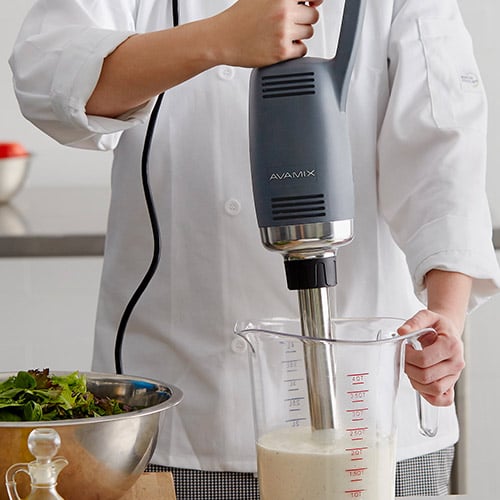Food Processor, Food Chopper, or Food Blender: What’s the Difference?Food processors, food choppers, and food blenders are all useful for prepping foods, with each one suited for specific tasks. All three units have their place in a commercial kitchen, but how do you know which one to use? We’ll outline the features of each appliance to help you choose the best equipment for your food truck, restaurant, or coffee shop.
Food Processor vs Chopper
The difference between a food processor and a food chopper is that a chopper uses manual power to force foods through stationery blades, and a processor uses electric power to spin sharp discs inside of a bowl or container. Food choppers come with blades that are suited for processing one type of produce, while food processors can be fitted with numerous blades that perform many tasks.
What is a Food Processor?

Food processors are electrical countertop appliances that use spinning blades to cut foods. Ingredients are added to the processor through a chute, so the operator’s hands never come into contact with the razor-sharp blades. Besides chopping, dicing, and grating vegetables, this appliance can blend hummus, mix bread dough, and emulsify dressings.
Reach for the food processor when you need to perform a labor-intensive task that would take a very long time to do by hand. There are two types of food processors that can be used for jobs of different sizes:
- Batch Bowl Food Processors – This type of food processor spins the blade inside a batch bowl or container. The bowl can only hold a set amount of ingredients before it becomes too full. When the batch is complete, the bowl can be removed and the ingredients can be poured out.
- Continuous Feed Food Processors – The continuous feed food processor is ideal for making very large batches. Instead of a batch bowl, the processed ingredients are forced through a chute into a container of your choosing. The food processor can be run continuously because it’s not limited by a batch bowl. Simply place a new container beneath the chute and continue processing.
What is a Chopper?

Food choppers are designed so the operator can place a single onion, tomato, or head of lettuce on the chopper, push or pull the handle, and force the item through the cutting blades. A container placed beneath the vegetable cutter catches the processed ingredients. Fruit and vegetable choppers are heavy duty, easy to clean, and produce consistent results so you know that all lemon wedges or tomato slices will be exactly the same size. Unlike a food processor, choppers cannot be used to puree or liquefy.
Reach for a food chopper vs a food processor if you need to create a specific type of cut and you want to have control over the size and quantity. There are several models of choppers suited to cutting specific ingredients:
- Wedgers, Dicers, and Slicers – These choppers come with blades that create wedge cuts, dice cuts, or slices. Most choppers will accept blade assemblies of different sizes so you can change the size of your cuts.
- Fry Cutters – Ideal for restaurants that go through a lot of french fries, these fry cutters slice potatoes into wedges, curly fires, ribbon fries, or straight-cut fries.
- Specialty Choppers – There are many choppers designed for a specific type of produce, like pineapple corers, lettuce cutters, and blooming onion cutters.
Food Processor vs Blender
Food blenders can be used for some of the same tasks as a food processor, with some differences. Both appliances can puree, liquefy, and blend, but a food blender cannot perform cuts on solid foods. The blade assembly on a food blender is best suited for liquefying ingredients to make soup, sauces, or pesto.
What is a Food Blender?

Food blenders feature a powerful blade assembly at the base of a tall, pitcher-like container. Ingredients are added to the jar, and the blade spins to blend fruits, vegetables, herbs, or even nuts. Many food blenders include different speeds or pulse functions to give the use more control over the blending process. Once the ingredients are blended, the jar is removable for easy pouring. Food blenders are best suited for ingredients with a lot of liquid, unlike food processors which are best for thick, dense foods.
Reach for a food blender when you need to liquefy foods. The shape and size of the blender jar makes it suitable for holding and pouring liquids.
What is an Immersion Blender?

Immersion blenders liquefy and puree foods without the use of a jar. These handheld, electric-powered, appliances can be moved around the kitchen and immersed into stock pots or mixing bowls. Powerful blades at the end of the blender allow you to puree soups or sauces directly in the initial pot, eliminating the need to transfer ingredients.
Reach for an immersion blender when you need to puree a large batch of ingredients and it’s not convenient to add them to a blender jar.
Now that you know the features of these three popular countertop appliances, you’ll be able to choose the best one for the job. The food processor is the most versatile unit and can cut down on your kitchen prep considerably by performing a variety of tasks. Food choppers are the best choice for making deliberate cuts and wedges on specific types of produce. Finally, the food blender is the most convenient appliance for liquefying ingredients.
